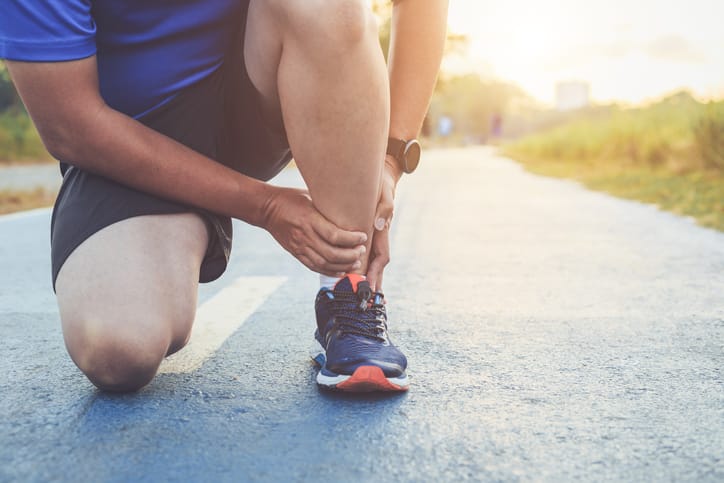Too much of a good thing can lead to an overuse injury that can keep you away from the activities you love.
Posted
by Featured Provider Eric Barp on Thursday, September 12, 2019
 There's little more invigorating than being active outdoors, especially when ideal weekend temperatures beckon you to do something you don't do most other days. You may be inspired to go for a long walk, hike or run. Or play a rigorous game of soccer, softball or baseball.
There's little more invigorating than being active outdoors, especially when ideal weekend temperatures beckon you to do something you don't do most other days. You may be inspired to go for a long walk, hike or run. Or play a rigorous game of soccer, softball or baseball.
But beware: Because your foot bears tremendous forces — sometimes more than 20 times your bodyweight — doing too much too soon can lead to overuse injuries and sideline you for months.
"We see an uptick in foot and ankle injuries when the weather warms," says Eric Barp, DPM, a foot and ankle surgeon with The Iowa Clinic. "On the weekends, people who want to get out and enjoy the weather do things they aren't used to doing. They go from zero to 100 all at once. They haven't prepared themselves for the sudden change in physical demands, and that can lead to injury."
Overuse injuries usually start small: Minor aches and pains result from rapid increases in exercise intensity, duration or frequency. Without rest and proper treatment, those tiny aches and pains can evolve into much more severe injuries.

Injure Yourself Over the Weekend?
If the pain and swelling are still present, get your foot or ankle injury evaluated.
Schedule a Podiatry Appointment
The older you get, the more likely you'll suffer an overuse injury.
You're enthusiastic about participating in a sport or activity. But you just don't have enough time to adequately train for it. Instead, you go all out when you do find a little time to fit your favorite activity into your schedule.
It's called "Weekend Warrior Syndrome." And it can lead to a variety of foot and ankle injuries:
Bursitis
The bursae are small fluid-filled pads that act as cushions between the bones and tendons near your joints. Too much repetitive motion and these pads become inflamed. Your heel or ankle feels achy and stiff. And you feel pain when you move, press on the bursa, wear shoes or exercise.
Achilles Tendonitis
Your Achilles tendon connects the calf muscles to the heel bone. Repetitive or intense strain can lead to inflammation or irritation of the soft tissues in and around your Achilles. You might feel a mild ache in the back of your leg or above your heel after running or participating in another activity. Achilles tendonitis is especially common in athletes who suddenly increase the intensity or duration of their activity.
Stress Fracture
Repetitive striking, like when you're jumping up and down, can damage the bones in your foot. The tiny, hairline cracks can be hard to see on an X-ray and may be difficult to notice at first.
Stress fractures begin as a minor pain in one part of your foot. With time, the foot pain worsens and you may see some swelling in the painful area. If you don't get it checked out, the fracture gets bigger and requires more serious medical help. It will also lead to a longer recovery time away from your favorite activity.
Plantar Fasciitis
There's a flat ligament known as the plantar fascia that runs across the bottom of your foot, connecting the heel bone to the toes. Overuse, being overweight or obese and wearing shoes with inadequate support can lead to irritation and inflammation of the ligament.
The inflammation leads to a stabbing pain at the bottom of your foot. Plantar fasciitis usually occurs with the first steps in the morning and may feel better throughout the day as your foot moves more and more. The injury is especially common in runners, but every weekend athlete can use a variety of treatments and stretches to fix their foot pain.
Metatarsalgia
The ball of your foot is another common spot for inflammation to occur. Similar to plantar fasciitis, metatarsalgia leads to foot pain — just more to the front of your foot. Any activity that involves running and jumping or wearing shoes that don't fit well can irritate the ball of your foot over time.
Exercising through foot and ankle pain can make your problem worse.
Many of the patients seen in The Iowa Clinic's Foot & Ankle Surgery department have tried to run or exercise through the pain, Dr. Barp says. "This can cause further injury. Tendonitis can lead to a ruptured tendon. A stress fracture can become a full bone fracture that requires surgery."
At the first sign of foot or ankle pain, back off what you're doing, Dr. Barp advises. Give it a day using the "RICE" self-care method:
- Rest – Don't put weight on the foot until the pain is gone or nearly gone.
- Ice – Apply ice (wrapped in a towel) to the injured area for 15-minute intervals.
- Compression – Wrap the injured area in an ACE bandage — but not too tight.
- Elevation – Raise and keep your foot above your heart to reduce swelling.
In their early stages, most overuse injuries respond well to these at-home treatments. If symptoms persist, or your injury is more severe, it may require pain relievers, heel cups, splints, crutches, steroid injections and, occasionally, surgery.
Physical therapy can also help. Foot and ankle pain don't occur in a vacuum. They're connected to the rest of your musculoskeletal system. The pain is often related to the back, hip, knee or other areas of the body.
"Even evaluating the arm swing could show weakness in the abdominal muscles which could ultimately affect a runner's foot mechanics," says Tara Reinders, PT, a physical therapist with The Iowa Clinic in West Des Moines who regularly helps identify factors that contribute to foot and ankle injuries.
"In physical therapy, we do a thorough musculoskeletal evaluation of our patient's whole body to identify specific impairments related to muscle length, strength and mobility. Because frequently there's more than one joint involved with the problem," she says.
Strength training and rest can help you avoid overuse injuries.
"Whether it's running, biking or working out in a fitness center, you can't expect to do it for an hour without having worked up to it," Dr. Barp says.
You have to train your body over time and build up your strength and endurance gradually.
"It's also wise to cross-train and do strength training. Many runners feel they need to run to have a good workout. That's just not the case," he says.
Rest is equally important. You have to give your body enough time to recover. Dr. Barp advises that you rest from any vigorous activity for a full 48 hours between workouts. So take a day off between runs, long bike rides or other physically-demanding activities.
"It's hard to convince long-distance runners that they need to rest between long or intense runs," Reinders adds. "But during that time, you can benefit from some type of strength training twice a week focusing on your abdominal, hip and thigh muscles."
The right shoes can help prevent foot and ankle injuries too.
You see more and more minimalist shoes or barefoot running shoes. The theory goes that runners perform better with this "natural" style of running.
Both Reinders and Dr. Barp disagree. It's not only important to wear shoes — the shoes must also be fit for your foot's characteristics. Exercising in shoes that don't fit puts you at greater risk of injury.
"We've worn shoes since we first started to walk," Dr. Barp says. "Our feet are not accustomed to running without support. Experience shows us that minimalist shoes actually create more injuries."
No matter your sport, shoes can help provide support, aid stability and protect your feet from wear and tear. These days, you have plenty of choices to match to your foot type and your activity. Go to a store specifically dedicated to your sport — they'll know which shoes are best for flat feet, high arches and specific activities. Many places allow you to try the shoes out before buying. And some online retailers let you test them out and return them for free if they aren't the right shoe for you.
"If you're a runner, have two pairs and let your shoes rest for one day," Reinders says. "It takes about 24 hours for the core in the back of the shoe to recover."
Children aren't immune to overuse injuries.
Children aren't immune to overuse injuries.
Too many kids are overextended. Sports are no longer limited to seasons and have become year-round activities with little to no time off. Some kids are involved in multiple sports all at once or start specializing at a young age, which can increase their risk of overuse injury. To prevent injuries, they really need to rest between activities and to work different muscles.
In fact, the American Academy of Pediatrics Council on Sports Medicine and Fitness recommends:
- Children should play multiple sports, but only one activity per season.
- Sports specialization should be delayed until your kid is at least 15.
- Young athletes should take at least three months off during the year from a particular sport, in one-month increments.
- They should get at least one to two days off per week.
Among youth, Dr. Barp sees Sever's disease more than any other foot or ankle problem. It stems from repetitive stress and pressure on the heel that leads to swelling of the growth plate. Your child may complain of heel pain, experience minor swelling or have difficulty walking.
Although painful, this condition exists only while a child is still growing and does not have long-term effects.
"Sever's disease doesn't go away on its own and can affect your child's ability to play sports to his or her full potential," Dr. Barp says. Treatment usually involves taking Tylenol and wearing heel cups — orthotic shoe inserts that absorb shock and help reduce pain.
Physical activity has major health benefits. But young or old, you have to know your limits. The first sign of many overuse injuries is a twinge of pain in a foot or ankle. Don't ignore it or fight through it. Visit a podiatrist or physical therapist to identify which overuse injury is affecting you and what you need to do to prevent it from limiting your activity.